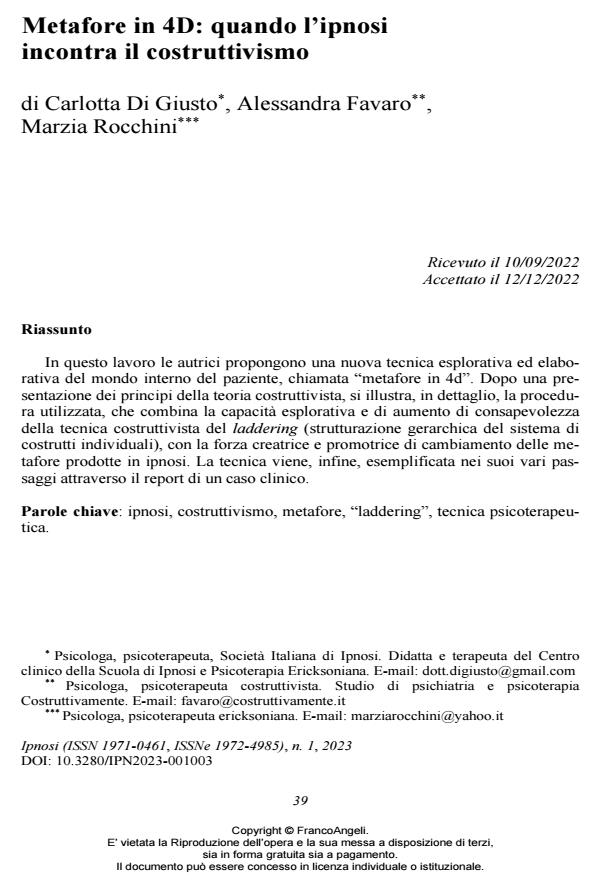Metaphors in 4D: when hypnosis meets constructivism
Journal title IPNOSI
Author/s Carlotta Di Giusto, Alessandra Favaro
Publishing Year 2023 Issue 2023/1
Language Italian Pages 10 P. 39-48 File size 288 KB
DOI 10.3280/IPN2023-001003
DOI is like a bar code for intellectual property: to have more infomation
click here
Below, you can see the article first page
If you want to buy this article in PDF format, you can do it, following the instructions to buy download credits

FrancoAngeli is member of Publishers International Linking Association, Inc (PILA), a not-for-profit association which run the CrossRef service enabling links to and from online scholarly content.
In this work, the authors propose a new exploratory technique of the patient’s inner world, named “4d metaphors”. Following an introduction to the principles of constructivist psychotherapy, the article illustrates in detail such innovative proce-dure aimed to combine the assumptions of the constructivist method of laddering (hierarchical structuring of the individual construct system) with the creative forces of the metaphors elicited during the hypnotic process, and the ensuing inner chang-ing potentials. The technique is exemplified and applied step-by-step to a clinical case study.
Keywords: hypnosis; constructivism; metaphors; laddering; psychotherapeutic technique.
- American Psychiatric Association (2013). DSM-5. Manuale diagnostico e statistico dei disturbi mentali. Milano: Raffaello Cortina Editore.
- Bannister D., Mair J.M.M. (1968). The evaluation of personal constructs. London: Academic Press.
- Casula C. (2004). Giardinieri, principesse, porcospini. Metafore per l’evoluzione personale e professionale. Milano: Franco Angeli.
- Epting F. (1990). Psicoterapia dei costrutti personali. Firenze: Martinelli.
- Erickson M.H., Rossi E.L., Rossi S.I. (1979). Tecniche di suggestione ipnotica. Roma: Astrolabio.
- Fransella F. (2003) International Handbook of Personal Construct Psychology. Chichester-UK: Wiley (pp. 257-264).
- Fransella F. (2003). Some skills and tools for personal construct practitioners. In F. Fransella (2003), ed., International Handbook of Personal Construct Psychology. Chichester-UK: John Wiley & Sons.
- Fransella F., Bell R., Bannister D. (2003). A Manual for Repertory Grid Technique (2nd edition). Chichester-UK: John Wiley & Sons.
- Hinkle D.N. (1965). The change of personal constructs from the viewpoint of a theory of construct implication. Unpublished PH.D. thesis, The Ohio State University.
- Hinkle D. (2010). A brief glance backward. Personal Construct Theory & Practice, 7, Supplement N° 1, vii-ix, 2010.
- Kelly G.A. (2004). La psicologia dei costrutti personali. Teoria e Personalità. Milano: Raffaello Cortina.
- Landfield A. (1971). Personal Construct Systems in Psychotherapy. Chicago: Rand-McNally.
- Leitner L. (2000). Levels of Awareness in Experiential Personal Construct Psychotherapy. Psychology Journal of Constructivist Psychology, 13, 239-252. DOI: 10.1080/107205399266091
- Leitner L., Thomas J. (2005). Experiential Personal Construct psychotherapy. International Handbook of Personal Construct Psychology, 257-264.
- Neimeyer R., Anderson A., Stockton L. (2001). Snakes versus ladders: a validation of laddering techniques as a measure of hierarchical structure. Journal of Constructivist Psychology, 14: 85-105. DOI: 10.1080/10720530125990
Carlotta Di Giusto, Alessandra Favaro, Metafore in 4D: quando l’ipnosi incontra il costruttivismo in "IPNOSI" 1/2023, pp 39-48, DOI: 10.3280/IPN2023-001003